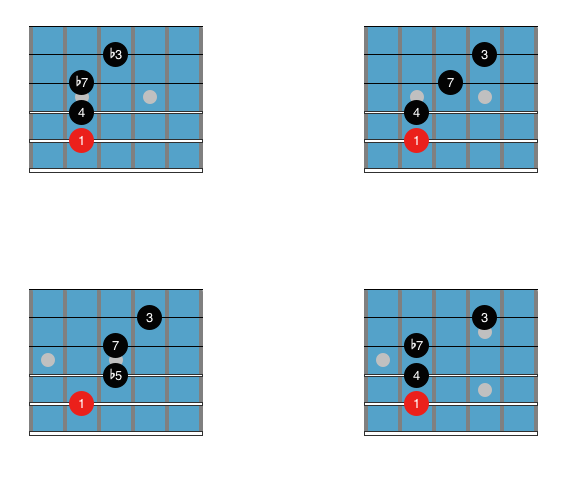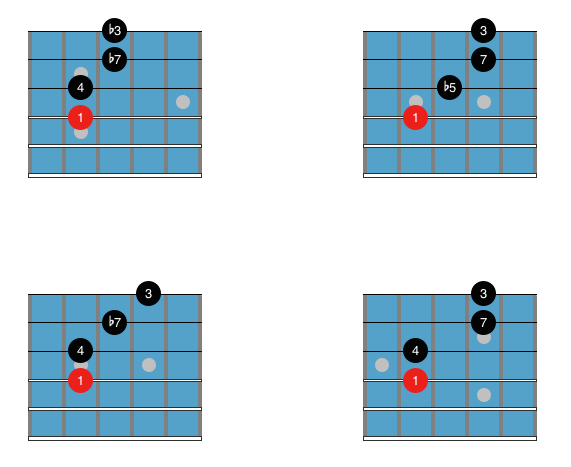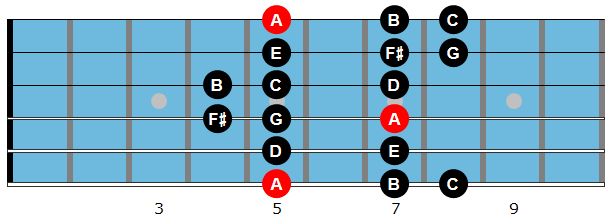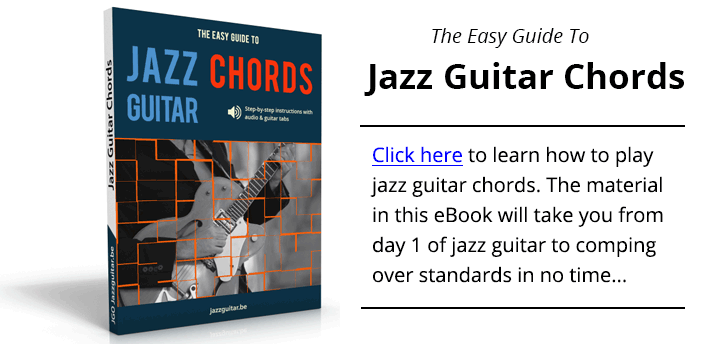Most of the guitar chords we use in jazz are constructed by stacking thirds. There are also chords based on stacking fourths instead of thirds. These quartal chords were made popular by McCoy Tyner (John Coltrane’s piano player) and Bill Evans (for example on Miles Davis’ standard So What from the album Kind of Blue).
Quartal voicings have a jazzy sound and work very well in modal music, but can be used on any jazz standard. In this lesson, you will learn how to construct quartal chords, how to use them on guitar and you will also play through some comping and soloing examples.
Lesson Content
Quartal Chord Construction
Let’s have a look at how quartal harmony works…
We start with the D Dorian scale (if the Dorian mode is new to you, check out this guitar modes lesson first):
| D Dorian Scale | D | E | F | G | A | B | C |
|---|---|---|---|---|---|---|---|
| 1 | 2 | b3 | 4 | 5 | 6 | b7 |
Let’s build a chord on the first note of the D Dorian scale, but instead of stacking thirds we’ll be stacking fourths (if chord construction is new to you, check out this chord theory lesson first):
| D | G | C | F |
| 1 | 11 | b7 | b3 |
The result is a chord you could call a Dm11, but I don’t want to give names to these quartal voicings because they behave like harmonic chameleons:
- If we put a D in the bass of our first example, we get a Dm11.
- With F in the bass, we get an F(6/9).
- G in the bass gives us a Gsus4.
Let’s build a quartal chord on the next note of the D Dorian scale (the result is an Em11):
| E | A | D | G |
| 1 | 11 | b7 | b3 |
We go on to the next note of the D Dorian scale (the result is an Fmaj7#11):
| F | B | E | A |
| 1 | #11 | 7 | 3 |
We can do this for all the notes of the D Dorian scale, but I think you get the picture by now…
Quartal Chords on the Guitar Neck
Let’s have a look at how quartal voicings look on the neck.
I like to look at and use quartal voicings more as a harmonized scale than as actual chords: they are very usable as a solo improvisation device. They also work well for accompaniment or for creating vamps.
4-Note Quartal Chords – A String Root
Here are all the quartal chords of the D Dorian scale on string set 2-3-4-5:
Listen & Play Along


If you played through the previous chords, you’ll notice there are only 4 chord shapes you need to remember:

4-Note Chords – D String Root
And here are all the quartal chords of the D Dorian scale on string set 1-2-3-4:
Listen & Play Along


Here are the guitar chord diagrams for the 4 chord shapes you have to remember:

How to Use Quartal Chords
To help get you started with applying quartal chords to your jazz guitar comping and chord-soloing ideas, here are three examples of how you would apply these cool-sounding chords to a ii-V-I chord progression.
Comping Example 1
This first example uses diatonic chords over a ii-V-I chord progression in C major.
Notice how certain quartal chords will sound more “inside” the changes, while others will sound a bit more “outside” the given chord. This is the reason that so many players love to use these chords in their comping and soloing, the fact that they can both sound inside and outside the changes even when using notes from the underlying parent key of the progression.
Listen & Play Along

Comping Example 2
This second example uses a technique that McCoy Tyner loves to use in his playing, as well as the great jazz guitarist Joe Diorio among others.
The idea behind this riff is that you play the quartal chord for Dm7, then you play the same shape up a minor 3rd interval, creating tension in your line that is then resolved down a half-step to the Em7 quartal chord over Cmaj7.
It’s not for everyone’s tastes, but it can be a great way to add a sense of modern jazz tension and release to your chord work.
Listen & Play Along

Comping Example 3
Here is an example of that same minor 3rd approach, only applied to a longer phrase and to each chord within that phrase.
Again, this will create a strong sense of tension in your lines, so you need to practice not only moving up a minor 3rd with these chords, but more importantly, resolving them after creating that tension.
Listen & Play Along

3-Note Quartal Chords
In this section, we’ll take a look at how you can derive fun and cool-sounding 3-note chords from the A Dorian mode, which you can then use to create chord soloing, comping and chord melody lines over m7 chords in your jazz guitar endeavors.
A Dorian Mode Fingering
To begin, let’s review a 6th-string fingering for the Dorian mode in the key of A.
If you know other Dorian mode fingerings that’s cool, but for the sake of this lesson, it will be worth getting this one under your fingers as it is going to be used to create the three-note Dorian chords below.
If you are new to the Dorian mode, then try putting on an Am7 backing track and soloing over that chord using only this one Dorian fingering.
This will help get the sound of the scale into your ears and get the scale under your fingers before moving on to the more difficult, 3-note Dorian chords further below.

Quartal 3-Note Chord Voicings
Now that you have the Dorian mode under your fingers, let’s learn how to play 3-note chords based on this scale fingering.
Though the Dorian mode can be tricky to get down on the fretboard, once you have learned this fingering it is very easy to create a series of eight 3-note chords that you can then use in your chord soloing, chord melody and comping ideas.
What you are going to do is just play the 5th fret followed by the 7th fret, with three notes being plucked/strummed at the same time to form each 3-note Dorian chord.
Here is how that will look like on paper, and sound against an Am7 chord. Once you have learned how to play these chords, try comping or soloing over an Am7 chord and use only these shapes to create your chordal lines and phrases.
As a guide, try using your index finger on the 5th-fret chords, and then use your ring finger on the 7th fret chords. This will allow for a smooth transition between each chord as you move up and down the scale shape in a comping or soloing situation.
Quartal 3-Note Chord Lick
To help you get started with bringing these quartal chords into your soloing ideas, here is a sample lick where these chord shapes are used to break up single lines being played over an Am7 chord.
While soloing with a Dorian mode (or the 3-note chords) isn’t that difficult on its own, it can be tricky to get the transition from single-notes to chords smooth and fluid on the fretboard.
Try learning this lick first, slowly with a metronome, and then build up speed from there. Once you have the lick down, put on an Am7 backing track and solo over that chord as you move between single-notes and chords, perhaps every bar or every two bars throughout the solo.
Listen & Play Along
Quartal 3-Note Arpeggios
As well as playing each chord as a 3-note chunk as we did in the previous two examples, you can arpeggiate these chords to break them up into single lines that you can then use to improvise over minor 7th chords where you want to deliver a Dorian vibe to your phrases.
Here is an example of how you can arpeggiate these chords, in this case starting on the lowest note and picking up to the highest note of each 3-note chord.
Try using your fingers, pick and fingers or alternate picking to get the best results as far as rhythm and groove are concerned.
If you are into sweep picking, you might be able to work that technique over these chords, but often times sweeping leads to inaccurate rhythms with these shapes, so if you find you are having trouble just switch to alternate picking instead.
Listen & Play Along
Once you have a handle on the ascending arpeggio, you can also practice starting on the highest note and arpeggiating down the chords, and then mixing the ascending and descending versions together.
Here is an example of the descending version of these chords, which you can practice from a technical and improvisational standpoint.
Quartal 3-Note Arpeggio Lick
To finish up, here is a sample lick that uses both the ascending and descending versions of the arpeggiated Dorian chords.
Start by learning this lick as written, then write out a few similar licks of your own, before fully improvising with the arpeggiated 3-note Dorian chords over a modal vamp or a tune where you have minor 7th chord shapes and sounds.
Listen & Play Along
Do you have a question about quartal chords? Share your thoughts in the comments section below…
More Jazz Guitar Chord Lessons
- 17 Essential Jazz Guitar Chords for Beginners
- Drop 2 Chords & Inversions
- Drop 3 Chords & Inversions
- Shell Chords (aka Guide Tone Chords)
- Major Chords
- Major 6 Chords
- Dominant Chords
- Minor Chords
- Minor/Major7 Chords
- Augmented 7 Chords
- The Mu Major Chord (Steely Dan)
- 20 Ways to Play II V I Chord Progressions
- Classic II V I Chord Solo Lines
- What Are Diatonic Chords?
- Essential Jazz Guitar Chord Exercises
- Joe Pass Chords
- Take 5 Chords for Guitar
- The Girl From Ipanema Chords









Hello, I thought I grasped this until we start on the F. Why is the first 4th a #4 ? I understand that it’s followed by a 7, because of its intervals. But the 1 to #4 instead of 1-4 escapes me. I always looked at fourths as 2-1/2 steps in between. Can anyone enlighten me or suggest better coffee? Thanks
My understanding is that you’re just dropping the 5th and inserting the 4th degree of the scale, which for the F Major chord is dropped from the C (5th) to the B (4th) when in the key of C).
Great lesson, thank you! Just a small note: McCoy Tyner is still alive and playing!
Thanks for the great work on this page in general.
Some of the quartal 3-notes derived from A dorian on the d and g string do not look like quartals.
You present:
xx555x
xx777x
xxx555
xxx777
quartal 3-notes would be:
xx557x
xx778x
xxx577
xxx788
(if only the starting notes you chose shall be covered.)
The voicings you presented are fun sounding and derived from A dorian as you said, but not all are quartals.
Hi, thanks for this article.
In your comping example #2 I see it like Dm7 Db7 CM7.
ficou maravilhoso , o desing , bem estrutural . parabéns
Hi there. Is it possible to use the quartal voicings with minor chord progressions!!!??? Using the Melodic or Harmonic MInor Scale!!! DO you have any lesson talinkg about that?
Trying to build the voicings yourself would be an excellent exercise.
Hi there. I come here very often, I really enjoy your tutorials. Great information on this site. But I noticed a mistake in the chordal construction section at the top of the page. The very last example of quartal chord construction, built on the third degree of a dorian scale (F), you correctly identified it as an Fmaj7#11, but in the yellow and black box you have mistakenly labelled the chordal tones.
You wrote:
F | B | E | A
1 | 4 | b7 | b3
It should be:
F | B | E | A
1 | #4 | 7 | 3
Thanks Joel, I fixed the typo…
wow! really awesome stuff. thank you very much.
When learning how to build chord solos on guitar, we sometimes feel like we have to learn complex from on line sites like getstartedguitar. com, I know its hard to finger chords and shapes all over the neck before we can dig into creating chord soloing lines on the guitar. But this platform would be really helpful in coming future.
Great stuff. Was this a series of lessons from a particular book(s)?
gracias,muy buena y bonita leccion
Very interesting—-I’m always looking for help re: accomp. to bluesy songs and partial chords could be part of the solution
Thankyou—-more please—!!
Thanks a lot for this tutorial
I’ve used the Dorian sacle before,(i.e. G over an A) but NOT with these approaches. This is a great concept
Thanks
HEY GRACIAS, thank you, Merci, 谢谢, obrigado,
Hey nice stuff,very useful,back to so what’ with some of these approaches.
Thank you.
What’s going on in the backing track? I know it’s Am7 but there are a few little embellishments….just curious 🙂
Hey, just moving between Am7 and Am9 that’s all. Try playing these chords to get a bit of that vibe.
xx5555
xx5557
xx7988
xx10121212
The power of Drop-2s!
Thank you for taking time to make us better jazz guitarists.
I really thank you for the time you guys take to send all these useful material. Great job!!!
Tbanks, Dirk. I’m learning to solo over Summertime (Am), so I this will be pretty useful. Thanks again.
Very usefull stuff,good explanation
“…keep it comin’ love, keep it comin’ love…” from KC and the Sunshine Band!
Awsome thank you Dirk
Hi,
Really cool sound
A while ago you did a finger style of “Don’t get Around much Anymore”
any chance of getting a copy.
Thanks Dirk
Hey Bob, it’s in issue 5 of the Premium lessons, I mailed you the link.
Dirk,
Where can I find the Premium lessons? I’d like to get my hands on “Don’t get around much anymore,” as well.
Scott
Good one. On the line with my R’n’R background and what I already play, but it’s a fresh approach. Cool
Dirk this is AMAZING, thank you! What a cool idea!!!
Really cool licks. Love the sound. Thank you so much!
who would have thought practicing scales could be turned into so much fun!
thanks, great lessons!
Thanks Dirk ill keep on practicing .I’m playing this cool sound
Thanks Dirk Very cool. Dorian three note arps. Looking forward to adding these.
Muchas gracias. Muy linda lecciòn.
Thank you so much! Excellent examples!
Great lesson Dirk, thanks.